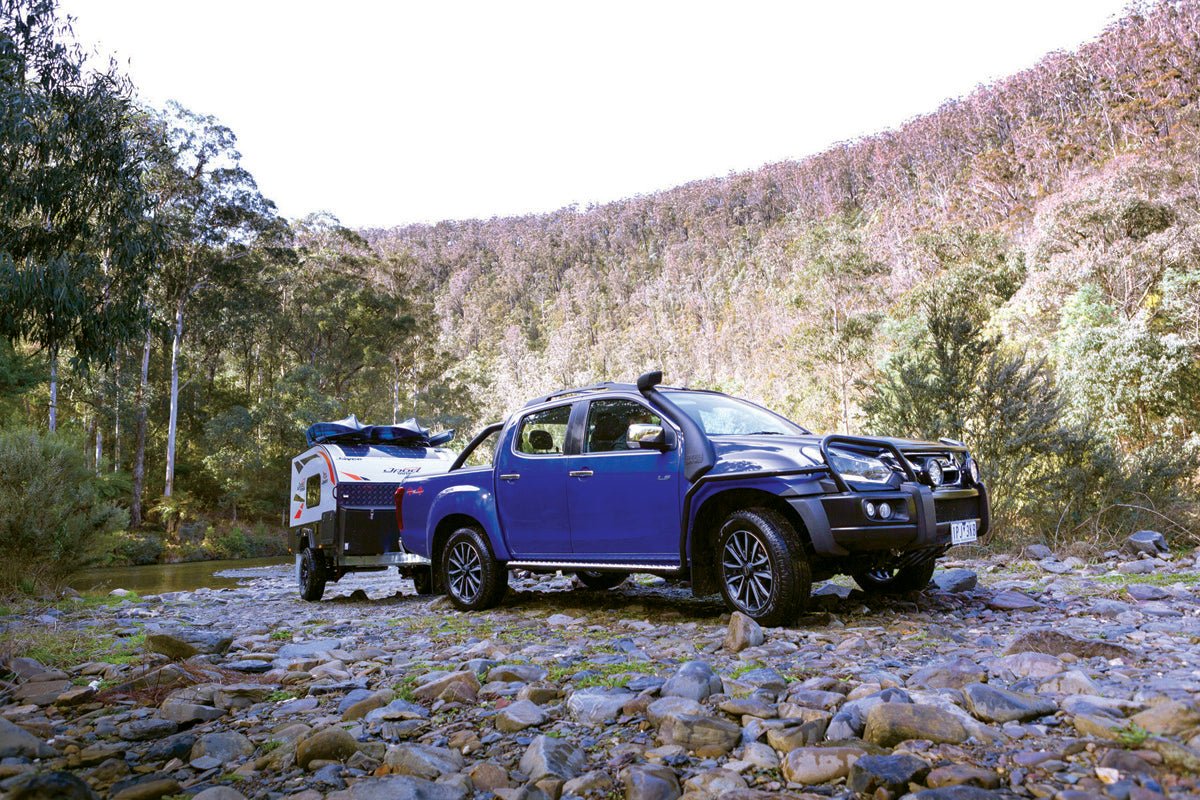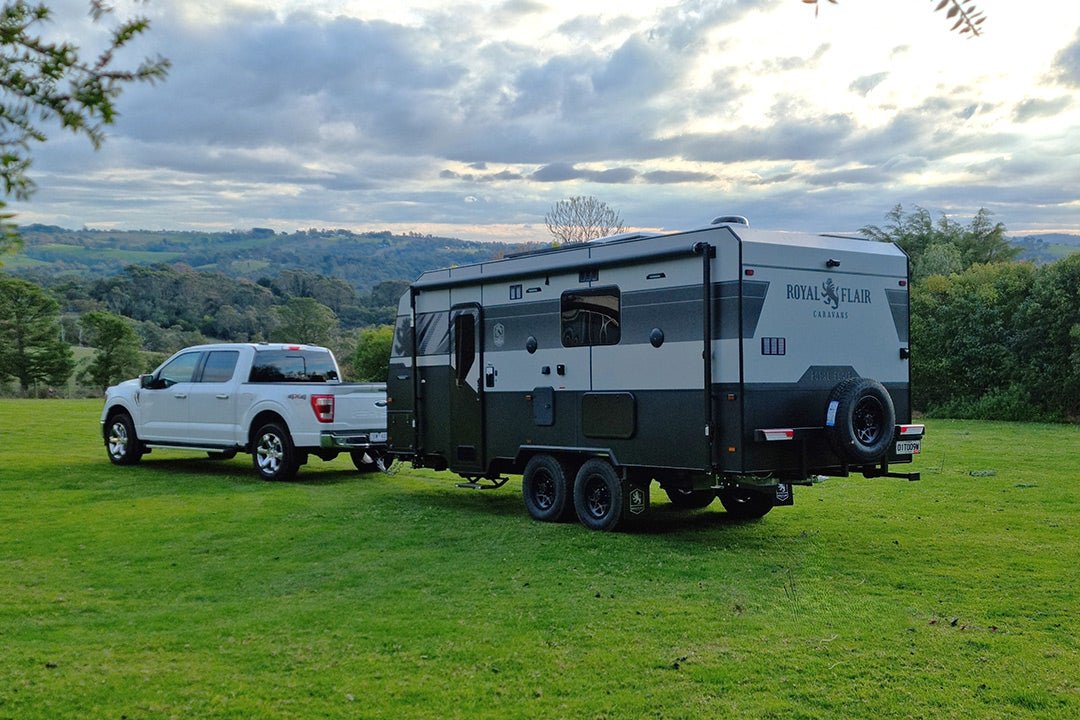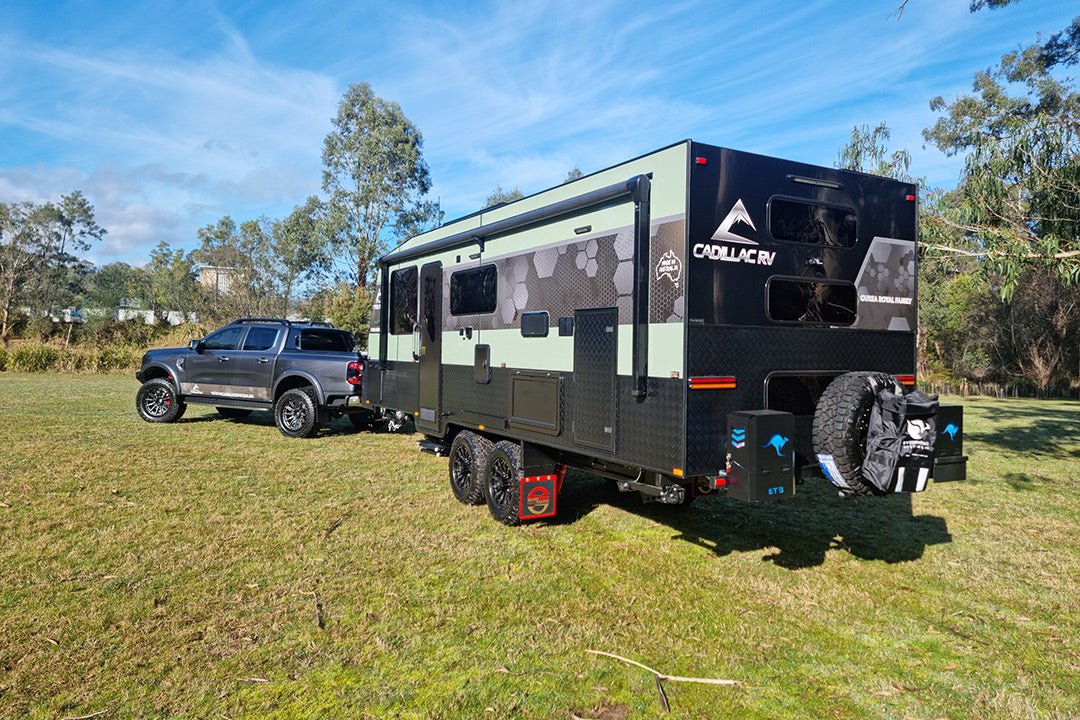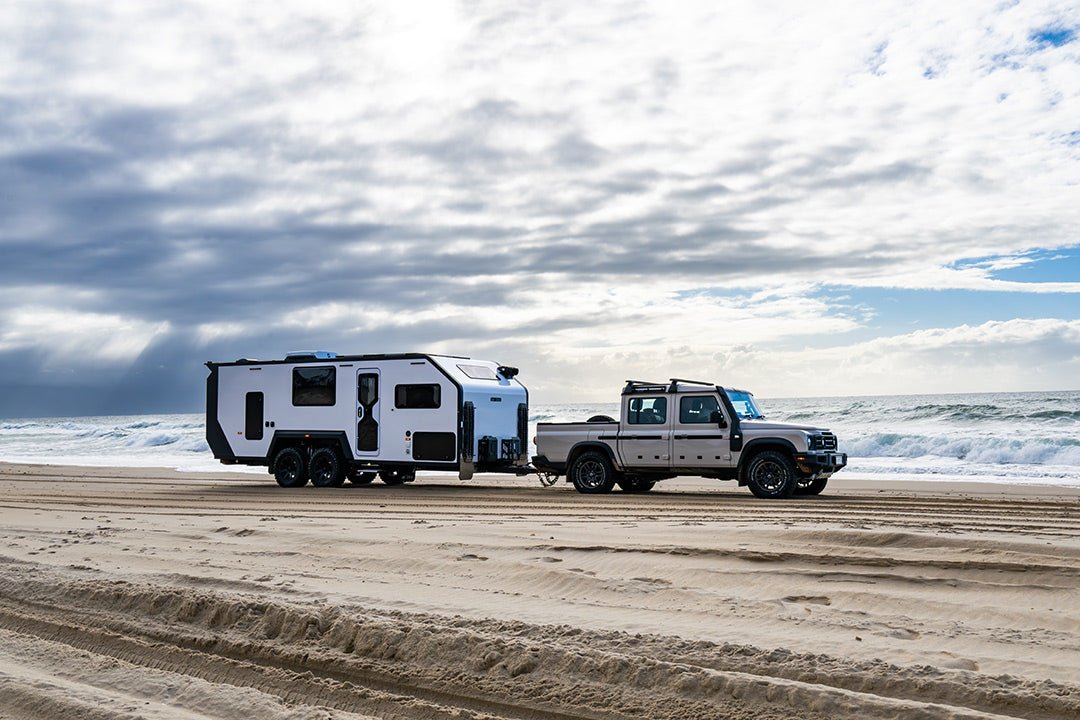Reliability on Wheels

The Isuzu D–MAX a household name in 4x4 vernacular. Caravan World recently took the crème de la crème, a 4X4 LS-T crew cab ute, on a towing expedition through Victoria’s mountainous north-east.
The MY19 iteration of this workhorse stays true to the principles that have made it so popular over recent years. Again we see the powerful motor, the generous towing capacity, and the sizeable payload; plus the reasonable value. Our test model came in at $54,800 (pre-accessories) and more basic 4X4 versions start at $38,200.
While the D-MAX isn’t overflowing with high-tech features and comforts, its bedrock of functionality and reliability make it particularly well suited to the caravanning lifestyle.
ITS MOTHER'S A TRUCKER
On top of passenger vehicles, Isuzu also produces trucks and specialist diesel engines. This crossover has greatly benefited its 4x4 range. We can trace the D-MAX’s trademark infusion of a passenger vehicle with truck-like functionality to its very first ute: the Isuzu WASP from 1963.
That long lineage brings us to 2019; now, a 4JJ1-TC Hi-Power 3.0L four cylinder turbodiesel engine resides under the D-MAX’s bonnet. This giant is geared towards freight-lugging. Motors built with this intention need to have a lot of torque, positioned low down, and high displacement, as well as a catalogue of other differences from your everyday matchbox.
This underhood Hercules delivers up to 430Nm of torque, peaking at a pleasingly low 2000 to 2200rpm, whereas power peaks at 130kW around 3600rpm. Many of the leading 4WDs are clustered around this mark on both measures, with only a few pushing much higher, such as the Holden Colorado to 500Nm and 147kW respectively.
THE WORLD ON ITS SHOULDERS
The D-MAX boasts a maximum towing capacity of 3.5t braked. None of the other big 4WD ute players top 3.5t (though it’s equalled by a few); and some can only handle closer to 3t (such as the Hilux and Triton).
The Isuzu D-MAX measures 5.295m by 1.855m tall and 1.86m wide. Unburdened it weighs 1970kg, with a kerb load of 2026kg. You can load in 1024kg before you reach the GVM of 3050kg. There are only a few utes that marginally top that payload (such as the Ranger and B-T 50); many others, like the Hilux, Triton and Navara, lapse behind in the 900kg range.
Having a payload like that you need corresponding storage space and you find that in the tray. This cavernous caboose measures 1.55m long, 46.5cm deep and 1.53m wide, narrowing to 1.1m between the wheel houses. Within there are four cargo tie-down points for retaining bigger items. There’s room for heaps of gear here — definitely an extended camping trip’s worth. In our test model there was also a handy 12V single accessory power socket near the tailgate, so you could have something charging in the tray, either while driving or at camp.
The GCM of 5950kg means you can simultaneously carry a heap onboard and on the towball. The roof rails up top of the LS-T are built to take 60 of those kilos. You can also fold down the two back seats for additional space; there’s even a dedicated tool storage area under them.
BEHIND THE WHEEL
The driving experience starts off on the right foot, and not just in terms of planting it. You can enter and start the vehicle with the keys in your pocket the whole time.
The engine is garrulous, something akin to a cat’s menacing purr amplified tenfold. This can impose a little upon the banter in the cab, or the deep, philosophical thought process, but personally I like to hear it. It’s a reminder this is a macho 4X4 and from it you can quickly infer how the engine is faring.
The six-speed automatic transmission performs well and makes appropriate choices. Because of the talkative engine, you do notice the changes more, and occasionally, when faced with an obscure speed limit, the D-MAX maintains high revs before transitioning. I appreciated its ability to engine brake and hold speed downhill using the gears. And as for the brakes proper – 300mm discs up front and 295mm drums up back – they managed to smoothly and promptly curb inertia. The factory-fit REDARC electronic brake controller helped to fine-tune how the trailer behaved when slowing down, too.
In regards to the quoted torque and power figures, they become mere numbers when behind the wheel. What matters is that when you begin to accelerate, with a heavy load behind you, the engine gets to work early and you gain momentum steadily, without any sense of struggle or effort.
That is certainly the case with the Isuzu D-MAX. We towed a one-tonne camper behind it — not by any means pushing its capacity — and found that when babysitting this lightweight RV it performed a dream.
I especially noticed the difference setting off from a standstill. The Isuzu lacks the 0 to 100 in 0.5 millisecond aspirations of certain vehicles, but in exchange you have immense pulling grunt and a linear growth of speed.
The word ‘workhorse’ appears to have been coined with the D-MAX in mind, yet the Isuzu never seems stressed by its workload. When accelerating and shifting upwards, with a sizeable load behind, the Isuzu stays relaxed — like a globetrotting stockbroker in a Hawaiian shirt, relaxing beachside and sipping a martini, who is actually, despite all appearances, making more money in a minute than most do a year.
That may have given the impression the D-MAX is thirsty. It’s not. The quoted combined economy is 7.9L per 100km. This compares favourably to quoted combined figures for other models — for example the Ford Ranger at 8.7L, the Mazda B-T 50 at 9.7L. It’s only really topped by the Navara, which is closer to 7L.
When towing approximately 1t on the highways, to and from the Victorian High Country, we recorded 12.5L per 100km for the D-MAX. With its fuel tank of 76L, you’d be able to tow a 1t camper in such circumstances for approximately 600km before needing to refill.
The Isuzu D-MAX cannot turn on a dime, but which 4WD can? That and the relatively stiff, effortful steering at low speeds may alienate some city-slickers who regularly use sardine-can parking lots — perhaps they’d prefer the MUX, which did lighten its steering this year. But when you’re towing, you don’t need a sharp circle and most would agree an under-responsive wheel is preferable to an over-excitable one.
THE DEAL ON UNSEALED
When it comes to special offroading capabilities, the D-MAX presents a respectable resume. A dial by your left hand allows you to adjust from 2WD high, 4WD high or 4WD low; traction control keeps your grip secure; hill start assist and hill descent control aid in dealing with harsh slopes.
Ground clearance is convincing at 235mm. With an approach angle of 30 degrees (helped by the short front overhang), departure of 22.7, and ramp-over of 22.3, this is no low-lying Ferrari scrapping on the Maccas turn-in. You’re well-above the obstacles so you can focus more on the clearances and measurements of the camper or van behind you.
On really nasty terrain you can detect a certain stiffness up back, particularly when the tray is unloaded. You could picture the D-MAX placing a hand on its lumbar spine, but in the driver’s seat it’s nothing like that; just a slight, muted conveyance of that which passes underneath the back two tyres.
This comes with the territory of utes and their commonly used leaf springs at the rear. It is in fact what enables the D-MAX’s 1t payload. You’ll feel it less when you’re carrying more, too. Isuzu softened the D-MAX ride last year by changing from five to three springs. Up front it’s smooth sailing and solid groundedness on independent coil springs on gas shocks.
Out of the factory, the tyres are now Highway Terrains. These offer minimal friction and keep the fuel economy attractively low, but they aren’t as flash off the beaten track, where we suffered a lack of traction and had to crack out the ARB E-Z deflator early. Many offroaders would opt to change them to A/Ts or M/Ts. One other missing offroad feature is limited slip-diff and diff-lock, which could disadvantage offroad extremists that find themselves with tyres off or almost off of the ground.
WITHIN THE CAB
After gaining entry to the cab via the easy-access side steps you are greeted by the welcoming interior. The seats are leather-accented and I was pleased with how comfortable the driver’s was; six-way adjustment allowed me to position my legs and arms at comfortable extension, and my back felt supported by wrap-around bolsters of the seat. The ample headroom and out-of-the-way positioning of the grab handles helped, too.
The panelling in the centre features the 8in touch screen unit with USB, iPod and bluetooth input, satellite navigation and a reverse camera. Below it are controls for the quick-acting climate control air-con, then below this various outlets including two USB outlets (there’s one up back too). The odometer can record two trips, including fuel economy; the speedometer is just analogue.
There’s a reasonable amount of storage. A popping lid opens on the dash to reveal a flat space. The glovebox has upper and lower compartments. There’s a cupholder tray between the front seats, compartments with bottle bulges in the side of doors, map holders on the back of the seats, and an overhead console with lights and a sunnies case.
The D-MAX lacks certain features such as Apple CarPlay and autonomous emergency brakes. Each buyer will have to weigh up the importance of these omissions, but it is reassuring to know that the D-MAX, thanks to considerations such as its six airbags, has a 5-star ANCAP safety rating.
NEW BLING FOR 2019
The 2019 instalment of the D-MAX stays similar to last year, with most changes being cosmetic. Visual changes include matte black wheels, new-look sidesteps, matte black roof rails, and added black colouration to the exterior. Colour won’t help you tow — you could do as well in a pure pink D-MAX — but what will help you is the very impressive customer service experience, which has been even further improved this year.
Isuzu offers an empowering trilogy of warranty, roadside assistance and capped price servicing. Warranty now extends to six years (150,000km), up from five. Complimentary roadside assistance is up to six years from five. Capped price servicing is at seven years or 105,000km.
Isuzu exceeds expectations on these fronts – its warranty and roadside assistance are one or more years longer than many other brands, and the capped price servicing is the longest for this class of vehicle. This not only means you can drive confidently; it also demonstrates Isuzu’s confidence in its product.
DRIVING OFF OVER THE HORIZON
Everything considered I was properly impressed by the Isuzu D-MAX. Some drivers might find it light on features and comforts; but for many, these absences are far outweighed by the Isuzu’s dominance with the fundamentals.
The reliability, attractive price point, and ability to carry whatever it is you wish to carry, make this a great way to decorate your camper or caravan’s drawbar.
SPECS
WEIGHTS AND MEASURES
Length: 5.29m
Width: 1.86m (excluding door mirrors)
Height: 1.85m
Wheelbase: 3.09m
Ground clearance: 235mm
Kerb mass: 2026kg
Payload: 1024kg
Gross Vehicle Mass: 3050kg
Gross Combined Mass: 5950kg
Towing capacity (unbraked/braked): 750/3500kg
Towball (max): 350kg
DRIVETRAIN
Engine: Isuzu 4JJ1-TC Hi-Power 3.0 litre turbodiesel, in-line four-cylinder, DOHC, 16-valve with Diesel Particulate Diffuser
Transmission: Six-speed automatic
Power: 130kW @ 3600 rpm
Torque: 430Nm @ 2000 to 2200 rpm
Gear ratios: 1st 3.600; 2nd 2.090; 3rd 1.488; 4th 1.000; 5th 0.687; 6th 0.580; reverse 3.732; final drive 3.727.
OPTIONS FITTED
Satin black steel bull bar ($2238.50), heavy-duty side rail and side-step package ($2,208.80), LED Driving Lamps ($947.10), electronic brake controller ($722.70), Satin Black Sports Bar ($844.80), black roller tonneau cover ($2512.40), 12V single accessory power socket ($264), crew cab roof rail cross bars ($427.90), snorkel ($965.80), towbar ($909.70), tub liner ($548.90), blue colour ($500)
GENERAL
Fuel capacity: 76L. Combined economy 7.9L per 100km
Suspension: Independent, high-ride, coil springs, gas shock absorbers, upper and lower wishbones, stabiliser bar (front); alloy-steel overslung long-span semi-elliptic leaf springs, gas shock absorbers (rear)
Brakes: 300mm diameter ventilated front discs with 2-piston calipers; 295mm rear drums
Wheels: 18in x 7in alloy; 255/60R18 Highway Terrain
Warranty: Six years/150,000km warranty, plus six years complimentary roadside assistance and seven-year/105,000km capped price servicing program.=
PRICE
RRP $54,800
As tested $65,994.80
MORE INFORMATION
To enquire about this vehicle, please contact Isuzu







